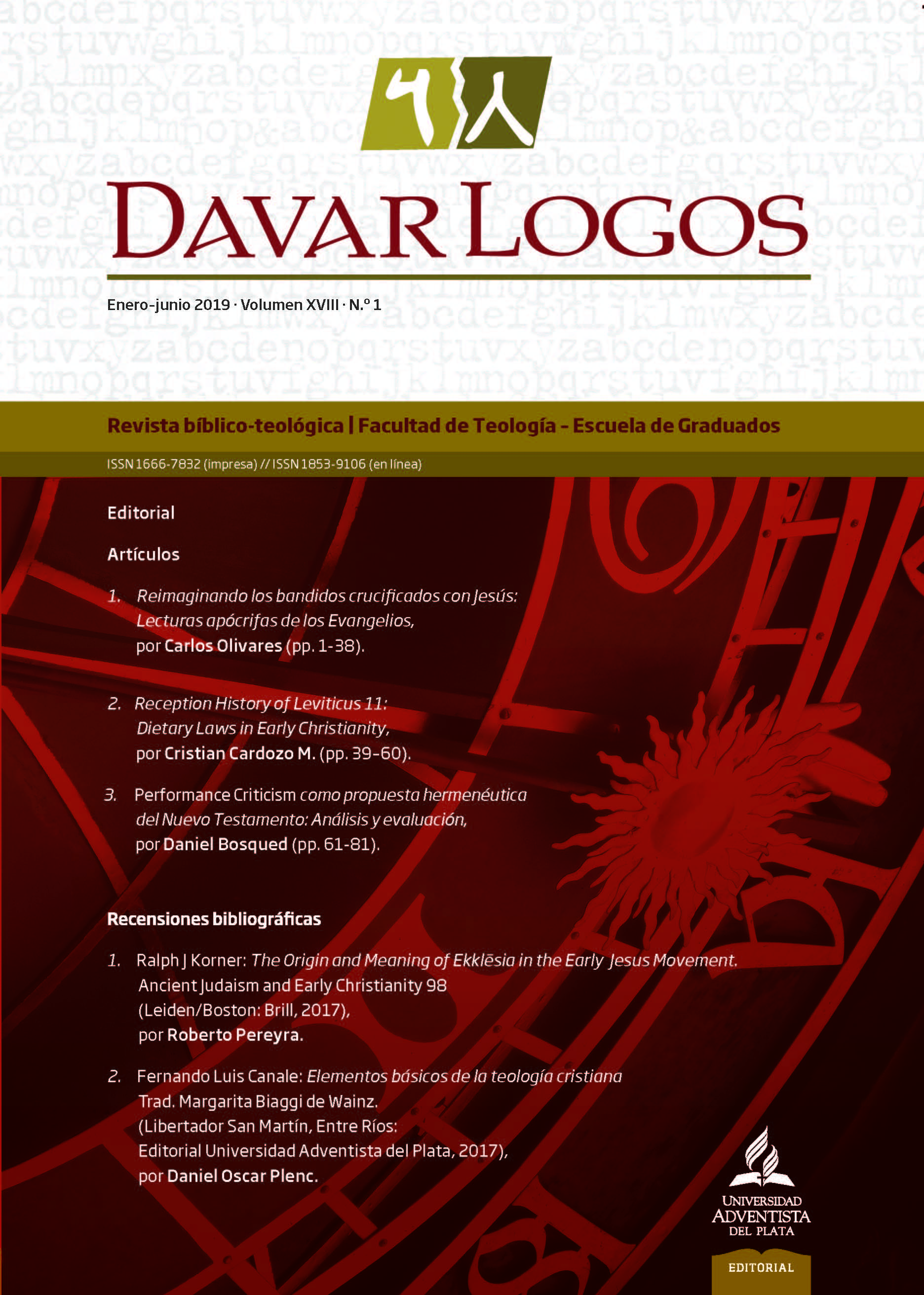Performance Criticism como propuesta hermenéutica del Nuevo Testamento
Análisis y evaluación
DOI:
https://doi.org/10.56487/723pbd69Palabras clave:
Performance Criticism — Análisis — Hermenéutica —Nuevo Testamento — Representación — EvaluaciónResumen
La llamada Performance Criticism está en pleno crecimiento hoy en día en los círculos neotestamentarios. Sus planteamientos se basan en estudios de oralidad y reclaman la necesidad de recuperar la naturaleza original de los textos bíblicos representados o actuados como herramienta hermenéutica. Sin embargo, esta corriente tiene significativas lagunas en sus presuposiciones y algunos errores conceptuales importantes que plantean serios desafíos a la hora de usarla como un método válido de interpretación bíblica.
Descargas
Referencias
El presente trabajo es parte del proyecto de investigación “Teología del Nuevo Testamento en el s. xxi: estado de la cuestión”, financiado por la Universidad Adventista del Plata.
Ver, por ejemplo, Markus Bockmuehl, Seeing the Word: Refocusing New Testament Study (Grand Rapids, MI: Baker Academic, 2013), 36; I. Howard Marshall, New Testament Theology: Many witnesses, One Gospel (Downers Grove, IL: Intervarsity Press, 2004), 17-47. Ver, también, Thomas R. Hatina, New Testament Theology and Its Quest for Relevance (Londres: Bloomsbury, 2013); y la respuesta de Wil Rogan, “Toward a Christian New Testament Theology: A Response to Thomas Hatina”, Journal of Theological Interpretation 9 (2015): 117-126. Algunos desafíos formales y materiales actuales ya los anticipaba D. A. Carson, en “Current Issues in Biblical Theology: A New Testament Perspective”, Bulletin for Biblical Research 5 (1995): 17-41.
Ver, por ejemplo, James D. G. Dunn, New Testament Theology: An Introduction (Nashville, TN: Abingdon Press, 2009), 7-10; Frank Thielman, Teología del Nuevo Testamento (Miami, FL: Vida, 2006), 30-47.
Ver al respecto James Crossley, Reading the New Testament: Contemporary Aproaches (Londres:Routledge, 2010), esp. 7-32.
Ver el análisis de Larry W. Hurtado, “Fashions, Fallacies and Future Prospects in New Testament Studies”, JSNT 36 (2014): 299-324.
Para un repaso sobre el desarrollo de la teoría de la “respuesta del lector”, ver John Clifford, The Experience of Reading: Louise Rosenblatt and Reader-Response Theory (Portsmouth, NH: Boynton/ Cook Publishers, 1991).
Así lo señala David Rhoads, “Performance Criticism: An Emerging Methodology in Second Testament Studies-Part 2”, Biblical Theology Bulletin 36 (2006): 167.
Para un resumen de su crecimiento, ver David Rhoads, “Performance Criticism: An Emerging Methodology in Second Testament Studies-Part 1”, Biblical Theology Bulletin 36 (2006): 120- 121. Actualmente, hay una serie monográfica dedicada al tema: Biblical Performance Criticism, publicada por Cascade Books. La Society of New Testament Studies ha tenido, recientemente, un seminario titulado “The New Testament, Oral Culture, and Bible Translation”, y la página web que concentra los recursos de esta propuesta hermenéutica contiene abundantes ejemplos de representaciones, vídeos, y artículos al respecto que muestran su constante progresión hoy en día: https://www.biblicalperformancecriticism.org.
Ver José M. Ruano de la Haza, “Editar a Calderón”, Monteagudo 4 (1999): 90.
Aunque el término performance no aparece en el Diccionario de la Real Academia, su uso cotidiano en diferentes disciplinas es bastante común en castellano.
También usa esta expresión Marlon Winedt en: “La Carta a los Efesios: Una breve orientación desde la retórica y la oralidad”, RIBLA 68 (2011): 15-25.
Richard W. Swanson, “Truth, Method, and Multiplicity: Performance as a Mode of Interpretation”, Currents in Theology and Mission 37, n.º 4 (2010): 313. Ver, también, David Rhoads y Joanna Dewey, “Performance Criticism: A Paradigm Shift in New Testament Studies”, en From Text to Performance: Narrative and Performance Criticisms in Dialogue and Debate, ed. Kelly R. Iverson, Biblical Performance Criticism 10 (Eugene, OR: Cascade Books, 2014), 1.
Ruano de la Haza, “Editar a Calderón”, 90.
David Trobisch, “Performance Criticism as an Exegetical Method: A Story, Three Insights, and Two Jokes”, en The Interface of Orality and Writing: Speaking, Seeing, Writing in the Shaping of New Genres, ed. Annete Weissenrieder y Robert B. Coote., Biblical Performance Criticism Series 11 (Tübingen, DE: Mohr Siebeck, 2015), 200.
Nicholas A. Elder señala dentro de la crítica audiovisual los estudios de oralidad, teoría de la memoria social, Performance Criticism, y el estudio de la Biblia en los medios audiovisuales [“New Testament Media Criticism”, Currents in Biblical Research 15, n.º 3 (2017): 315-337]. Para un análisis sobre Media Criticism y Hermenéutica Bíblica, ver Thomas E. Boomershine, “Peter’s Denial as Polemic or Confession: The Implications of Media Criticism for Biblical Hermeneutics”, Semeia 39 (1987): 47-68.
Cf. Trobisch, “Performance Criticism”, 197-198.
Ver al respecto D. C. Duling, “Memory, Collective Memory, Orality and the Gospels”, HTS Teologiese Studies 67 (2011): 1-11.
Para un breve análisis de estos vínculos, ver el reciente estudio de Peter S. Perry, “Biblical Perfor�- mance Criticism: Survey and Prospects”, Religion 10 (2019): 2-5.
Para un análisis de la colección de Parry, ver David Elmer, “The Milman Parry Collection of Oral Literature”, Oral Tradition 28, n.º 2 (2013): 341-354.
Pieter J. J. Botha, Orality and Literacy in Early Christianity, Biblical Performance Criticism 5 (Eugene, OR: Cascade Books, 2012), xi-xvi.
Werner H. Kelber, The Oral and the Written Gospel: The Hemeneutics of Speaking and Writting in the Synoptic Tradition, Mark, Paul, and Q (Filadelfia, PN: Fortress, 1983). Esta obra de Kelber es citada como fundacional prácticamente por todos los autores que proponen la CP.
Joanna Dewey, “Performance Criticism in Teaching the Gospel of Mark”, Perspectives in Religious Studies, 41, n.º 1 (2015): 62.
Rhoads, “Performance Criticism-Part 1”, 118-133; Rhoads, “Performance Criticism-Part 2”, 164-184.
Rhoads, “Performance Criticism-Part 1”, 118; 120.
Cuando se habla de oralidad en esta disciplina, se entiende la experiencia de las palabras a través del sonido (Botha, Orality and Literacy, 10).
Paul J. Achtemeier, “Omne verbum sonat: The New Testament and the Oral Environment of Late Western Antiquity”, JBL 109, n.º 1 (1990): 15; Rhoads, “Performance Criticism-Part 1”, 123.
Así lo sostienen Joanna Dewey, “The Gospel of Mark as an Oral/Aural Narrative: Implications for Preaching”, Currents in Theology and Mission 44, n.º 4 (2017): 7-10; Botha, Orality and Literacy, 24.
Thomas E. Boomershine, “Peter’s Denial as Polemic or Confession: The Implications of Media Criticism for Biblical Hermeneutics”, Semeia 39 (1987): 47.
Ruth Finnegan, Literacy and Orality: Studies in the Technology of Communication (Oxford, GB: Basil Blackwell, 1988), 111. Botha señala que los textos orales dependían de los escritos para su supervivencia y los escritos de los orales para su legitimidad, de forma que ambos géneros estarían inseparablemente unidos (Orality and Literacy, xvii).
Richard A. Horsley, “Oral Communication, Oral Performance and New Testament Interpretation”, en Method & Meaning, ed. Andrew B. McGowan y Ken Harold Richards (Atlanta, GA: Society of Biblical Literature, 2011), 125. Hay también posturas intermedias entre lo oral y lo escrito que proponen diferentes niveles de coexistencia entre ambas. Ver, por ejemplo, las cinco fases en el continuo entre oralidad y escritura que señala J. A. Loubser, “Media Criticism and the Myth of Paul, the Creative Genius, and His Forgoten Co-Workers”, Neotestamentica 32 (2000): 331-332.
William V. Harris, Ancient Literacy (Cambridge, MA: Harvard University Press, 1989), 61; Catherin Hezser, Jewish Literacy in Roman Palestine (Tübingen, DE: Mohr Siebeck, 2001). En Israel, Rhoads disminuye el porcentaje a un 2-3% (“Performance Criticism-Part 1”, 121).
Rhoads señala: “They were either written ‘transcriptions’ of oral narratives that had been composed in performance or they were composed orally by dictation and written for use in oral performance. These compositions were oral presentations […] perhaps more often than not, no written text was present to the event” (“Performance Criticism-Part 1”, 118).
Trobisch, “Performance Criticism”, 200.
Rhoads, “Performance Criticism-Part 1”, 119; 126.
Perry, “Biblical Performance Criticism”, 6. Por eso, para este autor, incluso las películas sobre la Biblia, reproducciones de videos bíblicos en Youtube, etc. se podrían considerar representaciones (performances) de este tipo.
Rhoads, señala incluso que las epístolas se usaban como guiones para la representación posterior y que los Evangelios se usaban como guías para ser representados. Ver “Performance Criticism- Part 2”, 164. Ver, también, Lee A. Johnson [“Paul’s Letters Reheard: A Performance-Critical Examination of the Preparation, Transportation, and Delivery of Paul’s Correspondence”, Catholic Biblical Quarterly 79 (2017): 62; 65], quien explora el valor distintivo de la representación de las cartas de Pablo como una explicación de su éxito misionero y sostiene en la misma línea que los portadores de las cartas de Pablo, necesariamente tuvieron que ser los que la representaban en la comunidad, pues Pablo no podía depender de alguien que pudiese leerlas en la iglesia.
Rhoads, “Performance Criticism-Part 1”, 125. En el caso de Apocalipsis, sobre la base del uso de artefactos literarios específicos como fórmulas, explicaciones del narrador, interjecciones y algunas estructuras internas. Ver al respecto Lourdes García Ureña, “The Book of Revelation: A Written Text Towards the Oral Performance”, en Ruth Escodel, ed., Between Orality and Literacy: Communication and Adaptation in Antiquity (Leiden, NL: Brill, 2014), 309-330.
Richard W. Swanson, “Truth, Method, and Multiplicity: Performance as a Mode of Interpretation”, Currents in Theology and Mission 37, n.º 4 (2010): 314.
Botha, Orality and Literacy, 163-164; P. J. J. Botha, “Mark’s Story as Oral Traditional Literature: Rethinking the Transmission of Some Traditions about Jesus”, HvTSt 47 (1991): 304-331; Rhoads, “Performance Criticism-Part 1”, 125; J. Dewey, “The Survival of Mark’s Gospel”, JBL 123 (2004): 495-507; A. C. Wire, The Case for Mark Composed in Performance (Eugene, OR: Cascade Books, 2011).
Dewey, “The Gospel of Mark”, 7-8; Richard A. Horsley, “Oral Communication, Oral Performance and New Testament Interpretation”, en Method & Meaning, ed. Andrew B. McGowan y Ken Harold Richards (Atlanta, GA: Society of Biblical Literature, 2011), 142.
Rhoads, “Performance Criticism-Part 2”, 165. Perry, “Biblical Performance Criticism”, 7, también hace énfasis en que la crítica de la performance trata de analizar la comunicación como un evento.
Kelly R. Iverson, “A Centurion’s ‘Confession’: A Performance-Critical Analysis of Mark 15:39”, JBL 130, n.º 2 (2011): 329-350. Para un resumen de las diferentes interpretaciones, ver Adela Yarbro Collins, Mark: A Commentary, Hermeneia (Minneapolis, MN: Fortress, 2007), 769-771.
Ver, por ejemplo, Donald H. Juel, A Master of Surprise: Mark Interpreted (Minneapolis, MN: Fortress, 1994), 74; Richard A. Horsley, Hearing the Whole Story: The Politics of Plot in Marks Gospel (Louisville, KY: Westminster John Knox, 2001), 252; Sharyn Dowd, Reading Mark: A Literary and Theological Commentary, Reading the New Testament Series (Macon, GA: Smyth & Helwys, 2000), 162; Stephen P. Ahearne-Kroll, The Psalms of Lament in Marks Passion: Jesus’ Davidic Suffering, SNTSMS 142 (Cambridge, GB: Cambridge University Press, 2007),
-21.
En ese sentido, se desmarca del debate hermenéutico respecto a la veracidad histórica del relato.
Iverson, “A Centurion’s ‘Confession’”, 330.
Para ello, se basa en la obra de David R. Olson, The World on Paper: The Conceptual and Cognitive Implications of Writing and Reading (Cambridge, GB: Cambridge University Press, 1994).
Iverson, “A Centurion’s ‘Confession’”, 332.
θαμβέω (1,27); συζητέω (1,27); σπλαγχνίζομαι (1,41); διαλογίζομαι (2,6; 11,31); κράζω (3,11; 5,7; 9,24; 10,47-48; 11,9; 15,13-14); διδάσκω (4,2; 9,31; 11,17; 12,35); φοβέω (4,41); εκπλήσσω (6,2; 7,37; 10,26); ομνύω (6,23; 14,71); στενάζω (7,34); διαστέλλω (8,15); άγανακτέω (10,14; 14,4); αγαπάω (10,21); αναθεματίζω (14,71); εμπαίζω (15,31).
Iverson, “A Centurion’s ‘Confession’”, 335-336.
Por ejemplo, los señalados por Earl S. Johnson, “Is Mark 15:39 the Key to Mark’s Christology?”, JSNT 31 (1987): 3-22, quien argumenta que la lealtad al emperador por parte de un soldado debía ser absoluta, por eso nadie arriesgaría su carrera con una confesión así.
Iverson, “A Centurion’s ‘Confession’”, 336-341. También menciona que se podría ampliar a los
personajes de Jairo y Judas.
Whitney Shiner, Proclaiming the Gospel: First-Century Performance of Mark (Harrisburg, PA: Trinity Press International, 2003), 143.
Shiner, Proclaiming the Gospel, 167. Según Shiner, estos marcadores tendrían tres características: (a) coincidirían con momentos de vindicación de Jesús, (b) constituyen un lenguaje especialmente estilizado, e (c) implican interrupciones de la narrativa. Para Iverson, en este caso del centurión se cumplirían las tres características (“A Centurion’s ‘Confession’”, 343).
Iverson, “A Centurion’s ‘Confession’”, 344.
Sobre todo, el argumento del ritmo silábico con la letra /o/ para argumentar la introducción de la confesión como un elemento verdadero.
David R. Seal, “A Performance-Critical Analysis of Revelation 1:5B-8”, Bibliotheca Sacra 175 (2018): 215-27.
Ibíd., 217. El autor se apoya para ello en las obras de Ugo Vanni, “Liturgical Dialogue as a Literary Form in the Book of Revelation”, New Testament Studies 37 (1991): 348-72; Raymond J. Starr, “Reading Aloud: Lectores and Roman Reading”, The Classical Journal 86 (1991): 337-43
Seal, “Performance-Critical Analysis”, 219. Saquí Seal cita la obra de Roger Van Otterloo, “Towards an Understanding of ‘Lo’ and ‘Behold’: Functions of ιδού and ϊδε in the Greek New Testament”, Occasional Papers in Translation and Textlinguistics 2 (1988): 34-40, que indica tres funciones diferentes para esta partícula, una de ellas (elegida por Seal) sería para reforzar la veracidad de lo que se va a pronunciar.
Seal, “Performance-Critical Analysis”, 222-223.
Por ejemplo, Ruge-Jones, “Performance Criticism”, 288-295; Swanson, “Truth, Method, and Multiplicity”, 316; Dewey, “Performance Criticism”, 61-72.
Loubser, Media Criticism, 329-345.
Como defiende, por ejemplo, Botha (Orality and Literacy, 9).
Rhoads, “Performance Criticism-Part 2”, 179 señala que las “performances” pueden proveer criterios para realizar juicios interpretativos. En la misma línea se pronuncia Trobisch (“Performance Criticism”, 200), indicando que la representación se puede usar incluso como metodología para probar métodos y teorías de interpretación.
Una de las críticas más demoledoras que se ha hecho a la crítica de la performance la ha realizado recientemente Larry Hurtado [“Oral Fixation and New Tesament Studies ‘Orality’, ‘Performance’ and Reading Texts in Early Christianity”, New Testament Studies 60 (2014): 321-340].
Como señala Achtemeier (“Omne verbum sonat”, 15).
Hurtado, “Oral Fixation”, 324. Ver también, la obra de H. N. Parker, “Books and Reading Latin Poetry”, en Ancient Literacies: The Culture of Reading in Greece and Rome, ed. W. A. Johnson y H. N. Parker (Oxford, GB: Oxford University Press, 2009), 186-229, en la que se apoya Hurtado para su análisis.
Hurtado, “Oral Fixation”, 325.
Botha, Orality and Literacy, 38.
Dewey, “Performance Criticism”, 61.
Ver, por ejemplo, Phil Ruge-Jones, “Performance Criticism as Critical Pedagogy”, Currents in Theology and Mission 37, n.º 4 (2010): 289.
Botha, Orality and Literacy, 38.
Ver B. M. W. Knox, “Silent Reading in Antiquity”, Greek, Roman and Byzantine Studies 9 (1968): 421-435; A. K. Gavrilov, “Techniques of Reading in Classical Antiquity”, Catholic Quarterly 47 (1997): 56-73; M. F. Burnyeat, “Postscript on Silent Reading”, Catholic Quarterly 47 (1997): 74-76.
Boomershine, “Peter’s Denial”, 47.
Hurtado, “Oral Fixation”, 326-330.
Ver, por ejemplo, la obra de Alan Millard, Reading and Writing in the Time of Jesus (Sheffield, GB: Sheffield Academic Press, 2001), 154-184. También, M. Beard et al., eds., Literacy in the Roman World (Ann Arbor, MI: Journal of Roman Archaeology, 1991); W. A. Johnson y H. N. Parker, eds., Ancient Literacies: The Culture of Reading in Greece and Rome (Oxford, GB: Oxford University Press, 2009); J. L. Franklin Jr., “Literacy and the Parietal Inscriptions of Pompeii”, Literacy in the Roman World, ed. M. Beard et al. (Ann Arbor, MI: Journal of Roman Archaeology, 1991): 77-98; R. S. Bagnall, Everyday Writing in the Graeco-Roman East (Berkeley, CA: University of California Press, 2011.
Como señala Rhoads, “Performance Criticism-Part 1”, 123. La comunidad de Qumrán, sin ir más lejos, no estaba dedicada a la recitación o la representación pública de literatura, sino que su énfasis estaba en las obras escritas. La introducción de Lucas menciona una intención histórica escrita, no representada (Lc 1,1-4). Y la propia estructura de las epístolas del Nuevo Testamento responde a patrones conocidos escritos, independientemente de que luego pudiesen ser leídos en voz alta en las iglesias. También constituye un argumento, como señala Hurtado, la indicación en Col 4,16 de que la carta se intercambie con la de la iglesia de Laodicea y sea leída –no representada– allí también. O que en 2 Pe 3,15-16 se haga mención de los escritos de Pablo y a “otras
escrituras”, sin referencia a obras representadas (Hurtado, Oral Fixation, 339).
Rhoads, “Performance Criticism-Part 1”, 124. En toda su argumentación, se echan en falta fuentes primarias que demuestren lo que Rhoads propone.
Johnson, “Paul’s Letters Reheard”, 60-62.
Ver Shimon Levy, The Bible as Theater (Portland, OR: Sussex Academic Press, 2000) y, especialmente, en relación con el evangelio de Juan, ver Jo-Ann A. Brant, Dialogue and Drama: Elements of Greek Tragedy in the Fourth Gospel (Peabody, MA: Hendrickson, 2004).
Hurtado, “Oral Fixation”, 334-335.
Iverson señala: “Though it is impossible to revert to a pre-literate mind-set and our only remains are written documents, we can and must do a better job of attempting to reconstruct likely performance scenarios that are based on the social realities of the first century” (“A Centurion’s ‘Confession’”, 330).
Como la explicación de Iverson para tratar de argumentar exactamente en qué momento la gente aplaudiría al ver la representación de Marcos (ibíd., 343).
Un problema es el abundante uso de fuentes secundarias por parte de los autores, pero una considerable ausencia de fuentes primarias para argumentar la importancia de la representación de los textos. Botha, por ejemplo, cita a Platón, Papías o Clemente de Alejandría para afirmar la preeminencia de lo oral en esos autores (Orality and Literacy, 28-37), sin embargo, no presenta ejemplos sobre la importancia de la representación de los textos.
Rhoads, “Performance Criticism-Part 1”, 127. Rhoads incluso argumenta que las composiciones escritas tienen expresiones explícitas que guían la representación como indicadores de volumen (gritó), gestos (tocó), expresiones faciales (lloró), postura corporal (miró), etc.
En este caso, la ilustración de la música como diseñada para ser escuchada no haría justicia al texto bíblico puesto que la diferencia entre leer un texto o escucharlo, si bien puede aportar matices, no cambia de forma sustancial el contenido transmitido en dicho texto.
Perry, “Biblical Performance Criticism: Survey and Prospects”, Religion 10 (2019): 1-15.
Descargas
Publicado
Número
Sección
Licencia
Derechos de autor 2019 DavarLogos

Esta obra está bajo una licencia internacional Creative Commons Atribución-NoComercial-CompartirIgual 4.0.





